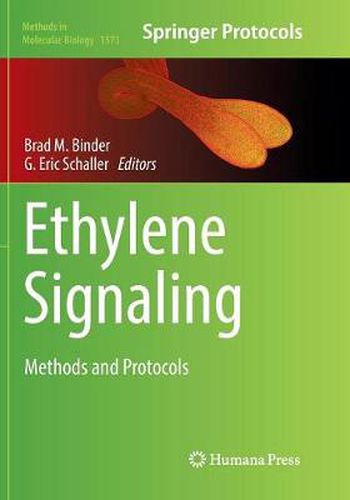Readings Newsletter
Become a Readings Member to make your shopping experience even easier.
Sign in or sign up for free!
You’re not far away from qualifying for FREE standard shipping within Australia
You’ve qualified for FREE standard shipping within Australia
The cart is loading…






This title is printed to order. This book may have been self-published. If so, we cannot guarantee the quality of the content. In the main most books will have gone through the editing process however some may not. We therefore suggest that you be aware of this before ordering this book. If in doubt check either the author or publisher’s details as we are unable to accept any returns unless they are faulty. Please contact us if you have any questions.
This volume provides a collection of protocols aimed toward the study of ethylene signaling in plants. Ethylene Signaling: Methods and Protocols is divided into three sections: ethylene biosynthesis, the signal transduction pathway, and the diverse ethylene responses of dicots and monocots. The chapters in section one discuss techniques for the measurement of activities related to the biosynthetic enzymes ACC synthase and ACC oxidase, the levels of ethylene synthesized by plants, and the treatment of plants with exogenous ethylene. Section two focuses on the analysis of the new membrane-associated proteins involved in the initial perception and transduction of the ethylene signal, such as ethylene receptors, CTR1, and EIN2. The third section covers assays applicable to dicots and monocots, including methods related to the roles of ethylene in germination, growth, abscission, abiotic stress, and defense. Section three also includes information on Arabidopsis mutants and the variety of chemical inhibitors that affect ethylene responses. Written in the highly successful Methods in Molecular Biology series format, chapters include introductions to their respective topics, lists of the necessary materials and reagents, step-by-step, readily reproducible laboratory protocols, and tips on troubleshooting and avoiding known pitfalls.
Thorough and comprehensive, Ethylene Signaling: Methods and Protocols is a valuable resource for both experienced and beginner researchers with prior experience in the study of ethylene signaling and for those who are just entering this exciting research field.
$9.00 standard shipping within Australia
FREE standard shipping within Australia for orders over $100.00
Express & International shipping calculated at checkout
This title is printed to order. This book may have been self-published. If so, we cannot guarantee the quality of the content. In the main most books will have gone through the editing process however some may not. We therefore suggest that you be aware of this before ordering this book. If in doubt check either the author or publisher’s details as we are unable to accept any returns unless they are faulty. Please contact us if you have any questions.
This volume provides a collection of protocols aimed toward the study of ethylene signaling in plants. Ethylene Signaling: Methods and Protocols is divided into three sections: ethylene biosynthesis, the signal transduction pathway, and the diverse ethylene responses of dicots and monocots. The chapters in section one discuss techniques for the measurement of activities related to the biosynthetic enzymes ACC synthase and ACC oxidase, the levels of ethylene synthesized by plants, and the treatment of plants with exogenous ethylene. Section two focuses on the analysis of the new membrane-associated proteins involved in the initial perception and transduction of the ethylene signal, such as ethylene receptors, CTR1, and EIN2. The third section covers assays applicable to dicots and monocots, including methods related to the roles of ethylene in germination, growth, abscission, abiotic stress, and defense. Section three also includes information on Arabidopsis mutants and the variety of chemical inhibitors that affect ethylene responses. Written in the highly successful Methods in Molecular Biology series format, chapters include introductions to their respective topics, lists of the necessary materials and reagents, step-by-step, readily reproducible laboratory protocols, and tips on troubleshooting and avoiding known pitfalls.
Thorough and comprehensive, Ethylene Signaling: Methods and Protocols is a valuable resource for both experienced and beginner researchers with prior experience in the study of ethylene signaling and for those who are just entering this exciting research field.